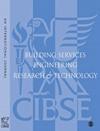Study on the cooling performance of a radiative cooling-based ventilated roof for its application in buildings
IF 1.8
4区 工程技术
Q3 CONSTRUCTION & BUILDING TECHNOLOGY
Building Services Engineering Research & Technology
Pub Date : 2022-06-02
DOI:10.1177/01436244221106342
引用次数: 0
Abstract
Radiative cooling has been demonstrated as an effective way to reduce building energy consumption especially for the recently developed diurnal radiative cooling materials. The most convenient application of radiative cooling materials is configured as the cool roofs. However, cool roofs will produce cooling energy throughout the year which will lead to the increase of heating penalty in the heating season. This phenomenon will offset part of the cooling benefit from radiative cooling. The ventilated roofs are also commonly employed in buildings for achieving energy-saving by reducing the heat gain from the roof to the building. To reduce the influence of radiative cooling in the heating season, a radiative cooling-based ventilated roof (RCVR) is proposed in this study by integrating the ventilated roof with the radiative cooling-based cool roof. The process of the heat transfer through RCVR is analyzed, and the simplified heat transfer model is developed. And then the effect of RCVR configuration on the room temperature is discussed in detail through CFD simulation. Finally, the annual electricity consumption of the building with RCVR is derived using EnergyPlus. The results show that the annual comprehensive performance of RCVR is superior to the cool roof and original roof since the total annual electricity consumption of the building with RCVR can be decreased by 21.8% and 16.9% compared with that of cool roof and original roof. Practical application: A radiative cooling-based ventilated roof (RCVR) is proposed by integrating the ventilated roof with the radiative cooling-based cool roof. The results show that the annual comprehensive performance of RCVR is superior to the cool roof and original roof. This study can provide the guiding significance for the application of RCVR, in which the building energy consumption can be further decreased for the application of radiative cooling in buildings.基于辐射制冷的建筑通风屋面制冷性能研究
辐射冷却已被证明是降低建筑能耗的有效方法,尤其是对于最近开发的昼夜辐射冷却材料。辐射冷却材料最方便的应用是配置为冷却屋顶。然而,凉爽的屋顶全年都会产生冷能,这将导致供暖季节供暖罚款的增加。这种现象将抵消辐射冷却带来的部分冷却效益。通风屋顶也通常用于建筑物中,以通过减少从屋顶到建筑物的热增益来实现节能。为了减少供暖季节辐射冷却的影响,本研究提出了一种基于辐射冷却的通风屋顶(RCVR),将通风屋顶与基于辐射冷却技术的通风屋顶相结合。分析了RCVR的传热过程,建立了简化的传热模型。然后通过CFD模拟详细讨论了RCVR配置对室温的影响。最后,使用EnergyPlus推导出了带有RCVR的建筑的年用电量。结果表明,RCVR的年综合性能优于冷屋顶和原屋顶,因为RCVR建筑的年总用电量比冷屋顶和原始屋顶分别降低了21.8%和16.9%。实际应用:通过将通风屋顶与基于辐射冷却的通风屋顶相结合,提出了一种基于辐射冷却通风屋顶(RCVR)。结果表明,RCVR的年综合性能优于冷顶和原顶。这项研究可以为RCVR的应用提供指导意义,其中辐射冷却在建筑中的应用可以进一步降低建筑能耗。
本文章由计算机程序翻译,如有差异,请以英文原文为准。
求助全文
约1分钟内获得全文
求助全文
来源期刊

Building Services Engineering Research & Technology
工程技术-结构与建筑技术
CiteScore
4.30
自引率
5.90%
发文量
38
审稿时长
>12 weeks
期刊介绍:
Building Services Engineering Research & Technology is one of the foremost, international peer reviewed journals that publishes the highest quality original research relevant to today’s Built Environment. Published in conjunction with CIBSE, this impressive journal reports on the latest research providing you with an invaluable guide to recent developments in the field.
 求助内容:
求助内容: 应助结果提醒方式:
应助结果提醒方式:


